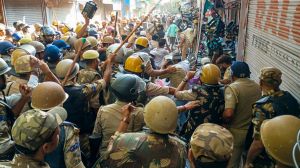Use this water with wisdom
Two events last week were milestones. A national magazine reported an All-India survey. In the recesses of the minds of a billion Indians li...

Two events last week were milestones. A national magazine reported an All-India survey. In the recesses of the minds of a billion Indians lie etched their heroes and villains, shaping their perceptions of hopes and fears, of shared memories and experiences, which we call culture. The man who conquered the minds of 85 per cent of all Indians — 85 per cent Hindus and 80 per cent Muslims was called Mohandas Karamchand Gandhi. With over 85 crore women and men idolising him, he has a permanent position in people’s hearts. But to 69 per cent of all Indians — 70 per cent Hindus and 57 per cent Muslims — Shivaji was a hero. Again, to 51 per cent Indians, Akbar is a hero — 49 per cent Hindus and 62 per cent Muslims. More surprising were the villains. Godse figured in the list, but the interesting finding was Mahmud Ghazni — 62 per cent of Indians don’t have a view on him, but 14 per cent Muslims saw him as a villain. India is the only country in the world where almost two crore Muslims see Ghazni as a villain. Religion, terribly important as it is, is not a significant factor in determining closely held ideals of many. I was eight years old when ‘at the stroke of the midnight hour India awoke to life and freedom’, as another great hero for all Indians said, but life was different then and half a century of the freedom experience is already shaping many of our minds together.
The rush of the waters of the Narmada into Gujarat on Wednesday August 17 went largely unnoticed in the national press. But for us in the state, the pain of the long years of waiting was over. The three years spent burning the midnight oil with some of India’s finest irrigation engineers and Syed Raza Hashim in Narmada Bhavan, Gandhinagar, was now a happy memory and turning, what a World Bank expert disdainfully called ‘lines on a map’, into a detailed vision of a mosaic of water blending with soils, climate and people, had ended as a labour of love.
If I had known the dam was going to spill, I would have gone to Kevadia, stood with the Adivasis, to welcome Narmada. As it is I went to Hansol, 144 km away, sat on the canal, exulting on the majesty of the largest and most sophisticated irrigation canal in the world, flowing with the Narmada’s waters, reminiscing on the events which are now history. The fights with the World Bank insisting that it was economically viable to pump a small river into Saurashtra and take a large river to Kutch and then on to Rajasthan. Rajiv Gandhi’s persistent questioning on waterlogging and rehabilitation and, after being convinced, his approval and enthusiastic support. Anil Patel’s hostility and, after getting his own rehabilitation plan support, his fight with the bureaucracy to get it implemented. The anger expressed by the Morse Commission, and its report which mocked Nehru and ignored Gandhiji’s Bhil Seva Mandal by saying that India’s freedom movement treated Adivasis as second-rate Hindus. The irony of being told by a friend, the social anthropologist John Harris, that on Narmada I was the Anti-Christ of the western world. As planning minister, convincing the sceptics that it was important to fund it under the Advanced Irrigation Benefit Programme with hundreds of crores, for the benefits would come if we covered the last mile.
|
The rush of the Narmada waters into Gujarat last week meant that the pain of long years of waiting was over |
The debate will now by definition change. Outside India, people have been convinced that the project has been stopped. Last year the influential French academic think-tank, Herodotte, was incredulous when I told them that the water was soon going to flow into Gujarat. The possibility of the project is no longer in doubt. Its benefits will now have to be argued out on the basis of facts. At this time it can be said that there has been a great augmentation of Gujarat’s resource base. The irrigation tunnel has already gone up to delivering ten thousand cusecs. The largest rivers in Gujarat have average flows, even in the monsoon period, less than that.
As soon as it starts raining in Madhya Pradesh, it starts gushing in Gujarat, until MP completes its Indira Sagar, that is. Until then, Gujarat literally has the entire river flow for itself, since its canal virtually has the capacity to carry the Yamuna in high flood. In Stage 1, when the upstream dam is not ready, it gets not 9 but 22 million acre feet of water, since all water which flows down the dam belongs to it. It must use this water with wisdom. Fill up all its tanks, recharge its groundwater and use the water for permanent environmental solutions. All this is possible only if the people are taken into confidence on the possibilities.
Irrigation engineers always think this is not possible. They should be sent elsewhere. We have proved to them in the Shedi branch of the Mahi that if you integrate the canal with village tanks, 15 per cent more water is available, even with limited flows. The quicker the system is completed, the larger the benefit can be. I can truthfully say that when I visited the villages in the command area, never did I find a community that did not recognise that water, even after Narmada, will be scarce, that it will have to be paid for, that it will have to go by need, which increases as you go down the canal. Everybody realised that hard choices will have to be made.
(Write to ykalagh@expressindia.com)







- 01
- 02
- 03
- 04
- 05
























